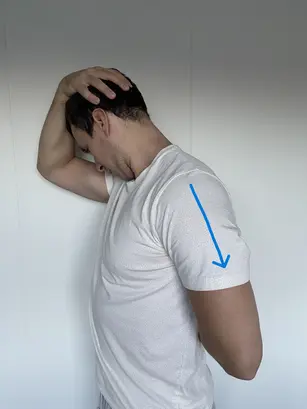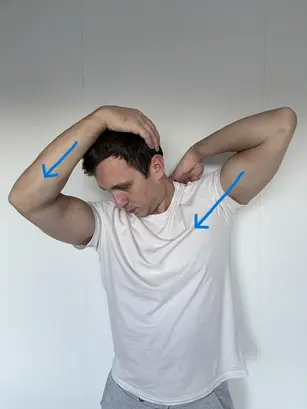4 Best Levator Scapulae Stretches for Neck Pain
Levator Scapulae muscle is often involved when neck muscle stiffness and/or neck pain when turning head to one side is present.
Learning to stretch this muscle is the first step to experiencing relief from levator scapulae pain.
That’s why I created this article. I want to show you the proper technique for stretching this muscle, including the 3 best levator scapulae stretches to combat neck pain.
4 Best Levator Scapulae Streches for Neck
Levator Scapulae Stretch
Start from a standing position with relaxed shoulders. Using your right hand, gently place it on the left side of your head. Slowly pull your head downward, directing your nose towards your right armpit. You should feel the stretch along the left side of your neck.
Hold this stretch for 30s.
Levator Stretch with Shoulder Depression
Start from a standing position with relaxed shoulders. Using your right hand, push your left arm downward and hold this position. Then rotate your head to the opposite side, and bend your head. This will place extra stretch on a levator scapulae muscle. Hold this position for 30s.
Levator Scapula Stretch with Hand Behind Back
Start from a standing position with relaxed shoulders. Place one hand behind back. Use the other hand to stretch your levator scapulae passively, moving your head to the opposite side and bending it. Hold this stretch for 30s.
Advanced Levator Scapulae Stretch
Start from a standing position with relaxed shoulders. Place one arm behind back, touching the upper part of shoulder blade. Then try to lower the shoulder blade as much as you can.
Using the other arm, push your head into flexion and rotation to the opposite side. Hold this stretch for 30s.
This is one of the best ways to stretch levator scapulae muscle, but also the hardest stretch to achieve.
How to Release Levator Scapulae
Here is my favorite technique to release the tension in levator scapulae, using a small massage ball (or tennis ball).
Start from standing position with your shoulders relaxed. Place a massage ball on wall and gently lean towards the massage ball with your upper back.
Place the levator scapulae trigger points on a massage ball. Here you can see the most common painful spots in this muscle.
While holding the pressure between your back and massage ball, stretch levator scapulae by rotating your head to the opposite side and tucking in your chin. Repeat this exercise ten times, each time holding the same pressure between levator scapulae trigger point and massage ball.
Perform this release for three rounds and you should feel the upper neck tension relief. Check out the stretching tools to help you relax your tight muscles.
How to Tell if you have Tight Levator Scapulae Muscle
The most effective way to find out if you have tightness in levator scapulae muscle is to lay down on your back and have one person to hold your shoulder and passively rotate and bend your head to the opposite side.
Reduced range of motion and upper neck tension (local) are indicators of levator scapulae tightness.
Why Stretching the Levator Scapulae is Important
With regular stretching levator scapulae you will improve range of motion in neck, reduce the chances of tightness in this muscle. These are the most common benefits of levator scapulae stretching.
Levator scapulae muscle is important for maintaining the good head and neck posture, especially to prevent the forward head posture.
Stretching this muscle is extremely important for office workers because prolonged sitting and working is often associated with neck pain and increased tightness in levator scapulae muscle.
Tips When Stretching Levator Scapulae
To achieve the most out of levator muscle stretching, follow these guidelines:
- Hold static stretch for 30s.
- Stretch daily, once per day.
- Do not rush into stretch, build the tension in muscle slowly.
- Dynamic stretches before static stretches.
- Breath deeply when stretching. That will ensure you better effect of stretching.
- Don’t stretch only levator scapulae muscle: focus on trapezius, lats, pectoralis, supraspinatus and infraspinatus muscles also.
- If you experience pain during stretching, stop and seek for medical attention.
Conclusion
Benefits of levator scapulae stretches are increasing the range of motion in neck and reducing the tightness in upper back muscles.
The best way to stretch levator scapulae muscle is to rotate your head to the opposite side and tuck in your chin (bend your head).
Simultaneously, you want to lower your shoulderblade, increasing the tension in levator scapulae when stretching.
Thank you for reading this article, but you don’t have to stop here.
Explore stretching routines for upper and lower body, posture and how to stretch like an athlete.
Learn more about that over here.





